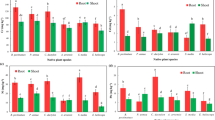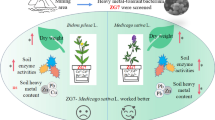Abstract
Coastal wetlands are subjected to increasing tetrabromobisphenol A (TBBPA) pollution, whereas knowledge of TBBPA degradation in marine environments is lacking. The changes of bacterial communities in TBBPA-polluted soil covered with halophytes were investigated. TBBPA could be degraded in the halophyte-covered saline-alkali soil in a microcosm experiment. Higher TBBPA removal occurred in the soil of Kandelia obovata compared with soils covered with Suaeda australis and Phragmites australis within 56 days of cultivation. The rhizosphere soils of S. australis, P. australis, and K. obovata mainly involved the classes of Bacteroidia, Gammaproteobacteria, Alphaproteobacteria, and Anaerolineae. Additionally, manganese oxidation, aerobic anoxygenic phototrophy, and fermentation functions were higher in the rhizosphere soil of K. obovata after TBBPA addition. This study supports that using suitable local halophytic plants is a promising approach for degrading TBBPA-contaminated coastal soil.




Similar content being viewed by others
References
Law RJ, Allchin CR, de Boer J, Covaci A et al (2006) Levels and trends of brominated flame retardants in the European environment. Chemosphere 64:187–208
de Wit CA (2002) An overview of brominated flame retardants in the environment. Chemosphere 46:583–624
Guyot R, Chatonnet F, Gillet B, Hughes S, Flamant F (2014) Toxicogenomic analysis of the ability of brominated flame retardants TBBPA and BDE-209 to disrupt thyroid hormone signaling in neural cells. Toxicology 325:125–132
Gong WJ, Zhu LY, Jiang TT, Cui H (2017) The occurrence and spatial-temporal distribution of tetrabromobisphenol A in the coastal intertidal zone of Qingdao in China, with a focus on toxicity assessment by biological monitoring. Chemosphere 185:462–467
Gu SY, Ekpeghere KI, Kim HY, Lee IS, Kim DH, Choo G, Oh JE (2017) Brominated flame retardants in marine environment focused on aquaculture area: occurrence, source and bioaccumulation. Sci Total Environ 601:1182–1191
Li H, Zhang Z, Sun Y, Wang W, Mai B (2021) Tetrabromobisphenol A and hexabromocyclododecanes in sediments and biota from two typical mangrove wetlands of South China: distribution, bioaccumulation and biomagnification. Sci Total Environ 750:141695
Wang W, Abualnaja KO, Asimakopoulos AG, Covaci A et al (2015) A comparative assessment of human exposure to tetrabromobisphenol A and eight bisphenols including bisphenol A via indoor dust ingestion in twelve countries. Environ Int 83:183–191
Bao Y, Niu J (2015) Photochemical transformation of tetrabromobisphenol A under simulated sunlight irradiation: kinetics, mechanism and influencing factors. Chemosphere 134:550–556
Lin K, Liu W, Gan J (2009) Reaction of tetrabromobisphenol A (TBBPA) with manganese dioxide: kinetics, products, and pathways. Environ Sci Technol 43:4480–4486
Ronen Z, Abeliovich A (2000) Anaerobic-aerobic process for microbial degradation of tetrabromobisphenol-A. Appl Environ Microb 66:2372–2377
Voordeckers JW, Fennell DE, Jones K, Max MH (2002) Anaerobic biotransformation of tetrabromobisphenol A, tetrachlorobisphenol A, and bisphenol A in estuarine sediments. Environ Sci Technol 36:696–701
George KW, Häggblom MM (2008) Microbial O-methylation of the flame retardant tetrabromobisphenol-A. Environ Sci Technol 42:5555–5561
Li F, Jiang B, Nastold P, Kolvenbach BA, Chen J, Wang L, Guo H, Corvini PFX, Ji R (2015) Enhanced transformation of tetrabromobisphenol A by nitrifiers in nitrifying activated sludge. Environ Sci Technol 49:4283–4292
Li F, Wang J, Jiang B, Wang X, Nastold P, Kolvenbach B, Wang L, Ma Y, Corvini PFX, Ji R (2015) Fate of tetrabromobisphenol A (TBBPA) and formation of ester-and ether-linked bound residues in an oxic sandy soil. Environ Sci Technol 49:12758–12765
Gu C, Wang J, Zhao ZL, Han Y, Du M, Zan S, Wang F (2019) Aerobic cometabolism of tetrabromobisphenol A by marine bacterial consortia. Environ Sci Pollut R 26:23832–23841
Williams C (1996) Combatting marine pollution from land-based activities: Australian initiatives. Ocean Coast Manage 33:87–112
McGenity TJ (2014) Hydrocarbon biodegradation in intertidal wetland sediments. Curr Opin Biotech 27:46–54
Tong F, Gu X, Gu C, Ji R, Tan Y, Xie J (2015) Insights into tetrabromobisphenol A adsorption onto soils: effects of soil components and environmental factors. Sci Total Environ 536:582–588
Liu HH, Hu YJ, Luo P, Bao LJ, Qiu JW, Leung KMY, Zeng EY (2014) Occurrence of halogenated flame retardants in sediment off an urbanized coastal zone: association with urbanization and industrialization. Environ Sci Technol 48:8465–8473
Yang CW, Liao CS, Ku H, Chang BV (2019) Biodegradation of tetrabromobisphenol-A in mangrove sediments. Sustainability 11:151
Jiang Y, Lu H, Xia K et al (2020) Effect of mangrove species on removal of tetrabromobisphenol A from contaminated sediments. Chemosphere 244:125385
Zhang X, Zhang L, Zhang L, Ji Z, Shao Y, Zhou H, Bao Y, Qu Y, Liu L (2019) Comparison of rhizosphere bacterial communities of reed and Suaeda in Shuangtaizi river estuary, Northeast China. Mar Pollut Bull 140:171–178
Liu M, Liu D, Xu Y, Xu J, Zhou Z, Wang P (2015) Fate and stereoselective behavior of benalaxyl in a water-sediment microcosm. J Agr Food Chem 63:5205–5211
van den Brink PJ, Tarazona JV, Solomon KR, Kanacker T, van den Brink NW, Brock TC, Hoogland JP (2005) The use of terrestrial and aquatic microcosms and mesocosms for the ecological risk assessment of veterinary medicinal products. Environ Toxicol Chem 24:820–829
Masella AP, Bartram AK, Truszkowski JM, Brown DG, Neufeld JD (2012) PANDAseq: paired-end assembler for illumina sequences. BMC Bioinformatics 13:1–7
Lozupone C, Lladser ME, Knights D, Stombaugh J, Knight R (2011) UniFrac: an effective distance metric for microbial community comparison. ISME J 5:169–172
Louca S, Parfrey L, Doebeli M (2016) Decoupling function and taxonomy in the global ocean microbiome. Science 353:1272–1277
Jing C, Xu Z, Zou P, Tang Q, Li Y, You X, Zhang C (2019) Coastal halophytes alter properties and microbial community structure of the saline soils in the Yellow River Delta. China Appl Soil Ecol 134:1–7
Gu C, Shi J, Rui J, Yu Y, Huang W, Lu Z, Chen Y, Chen X, Dong S, Hu Z, Ye C (2022) Halophyte vegetation influences soil microbial community of coastal salt marsh. J Ocean Univ China 21:1549–1556
Wang X, Sun R, Tian Y, Guo K, Sun H, Liu X, Chu H, Liu B (2020) Long-term phytoremediation of coastal saline soil reveals plant species-specific patterns of microbial community recruitment. Systems 5:e00741-19
Jickells TD (1998) Nutrient biogeochemistry of the coastal zone. Science 281:217–222
An F, Niu Z, Liu T, Su Y (2022) Succession of soil bacterial community along a 46-year choronsequence artificial revegetation in an arid oasis-desert ecotone. Sci Total Environ 814:152496
Sun H, Jiang L, Cui L, Feng W, Wang Y, Zhang J (2019) Soil organic carbon stabilization mechanisms in a subtropical mangrove and salt marsh ecosystem. FEMS Microbiol Ecol 54:351–365
Mujakić I, Piwosz K, Koblížek M (2022) Phylum Gemmatimonadota and its role in the environment. Microorganisms 10:151
Zhou H, Zhang D, Jiang Z, Sun P, Xiao H, Yuxin W, Chen J (2019) Changes in the soil microbial communities of alpine steppe at Qinghai-Tibetan Plateau under different degradation levels. Sci Total Environ 651:2281–2291
Zhu X, Wang L, Zhang X, He M, Wang D, Ren Y, Yao H, Ngegla J, Pan H (2022) Effects of different types of anthropogenic disturbances and natural wetlands on water quality and microbial communities in a typical black-odor river. Ecol Indic 136:108613
Gu C, Wang J, Guo M, Sui M, Lu H, Liu G (2018) Extracellular degradation of tetrabromobisphenol A via biogenic reactive oxygen species by a marine Pseudoalteromonas sp. Water Res 142:354–362
Ma Q, Meng N, Su J, Li Y, Gu J, Wang Y, Wang J, Qu Y, Zhao Z, Sun Y (2023) Unraveling the skatole biodegradation process in an enrichment consortium using integrated omics and culture-dependent strategies. J Environ Sci 127:688–699
Chi Z, Wang W, Li H, Wu H, Yan B (2021) Soil organic matter and salinity as critical factors affecting the bacterial community and function of Phragmites australis dominated riparian and coastal wetlands. Sci Total Environ 762:143156
Remucal C, Ginder-Vogel M (2014) A critical review of the reactivity of manganese oxides with organic contaminants. Environ Sci-Proc Imp 16:1247–1266
Jiao N, Sieracki ME, Zhang Y, Du H (2014) Aerobic anoxygenic phototrophic bacteria and their roles in marine ecosystems. Chinese Sci Bull 48:1064–1068
Funding
This work is supported by a grant from the Postdoctoral Advance Programs of Zhejiang Province (ZJ2021022 and ZJ2021048).
Author information
Authors and Affiliations
Contributions
CG and FZ conceived and designed the study. QXS and RWG conducted the literature search and performed the experiments. WKL was involved in the analysis and interpretation of data. CG drafted the manuscript. QS: The study was supervised and tutored. All authors read and approved the final manuscript.
Corresponding author
Ethics declarations
Conflict of interest
The authors declare no competing interests.
Human and animal participants
This study does not involve any human participants or animal experiments.
Additional information
Publisher's note
Springer Nature remains neutral with regard to jurisdictional claims in published maps and institutional affiliations.
Responsible Editor: Acacio Aparecido Navarrete
Rights and permissions
Springer Nature or its licensor (e.g. a society or other partner) holds exclusive rights to this article under a publishing agreement with the author(s) or other rightsholder(s); author self-archiving of the accepted manuscript version of this article is solely governed by the terms of such publishing agreement and applicable law.
About this article
Cite this article
Gu, C., Zhang, F., Lu, K. et al. Response of microbial community in the soil of halophyte after contamination with tetrabromobisphenol A. Braz J Microbiol 54, 975–981 (2023). https://doi.org/10.1007/s42770-023-00950-2
Received:
Accepted:
Published:
Issue Date:
DOI: https://doi.org/10.1007/s42770-023-00950-2




